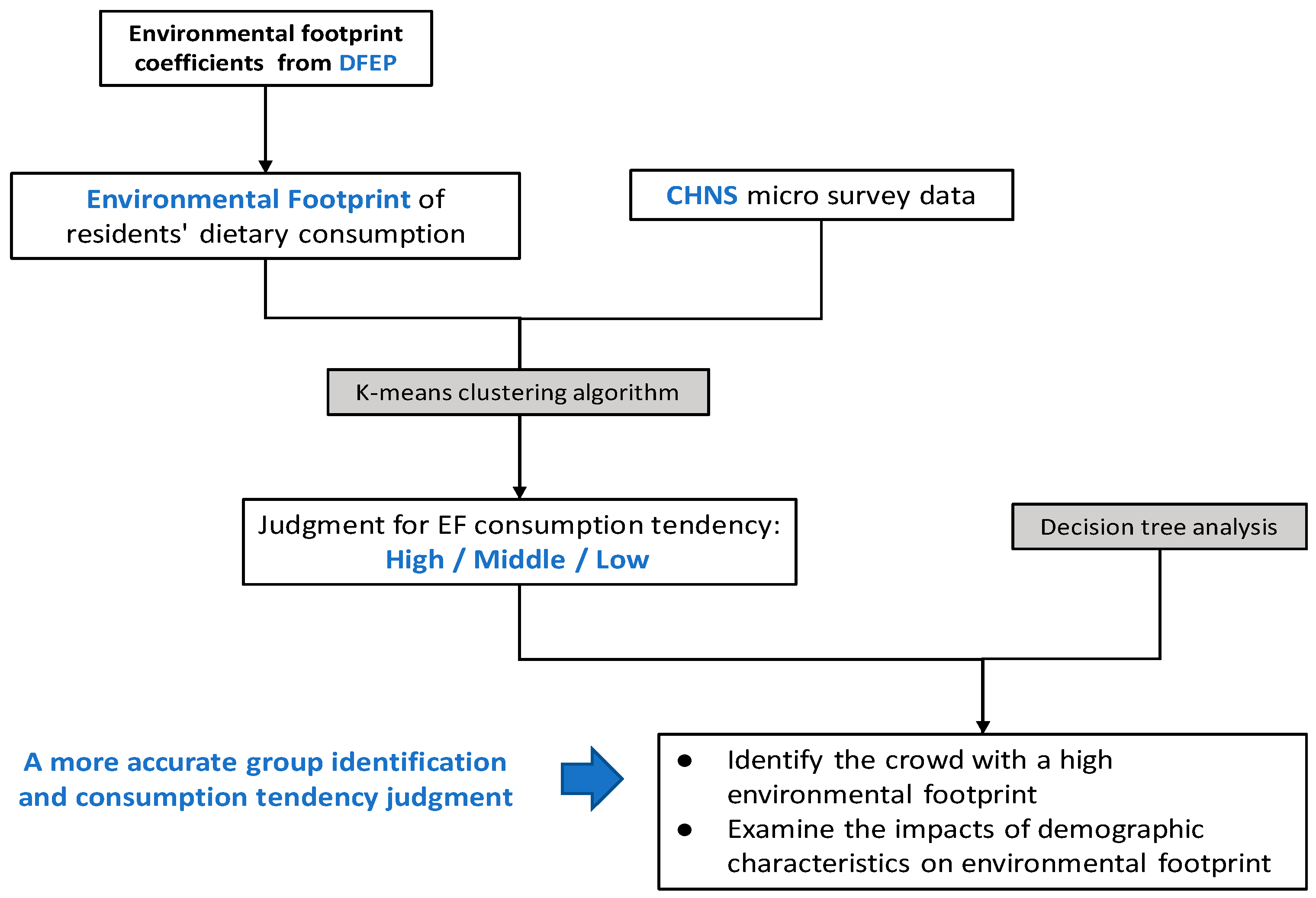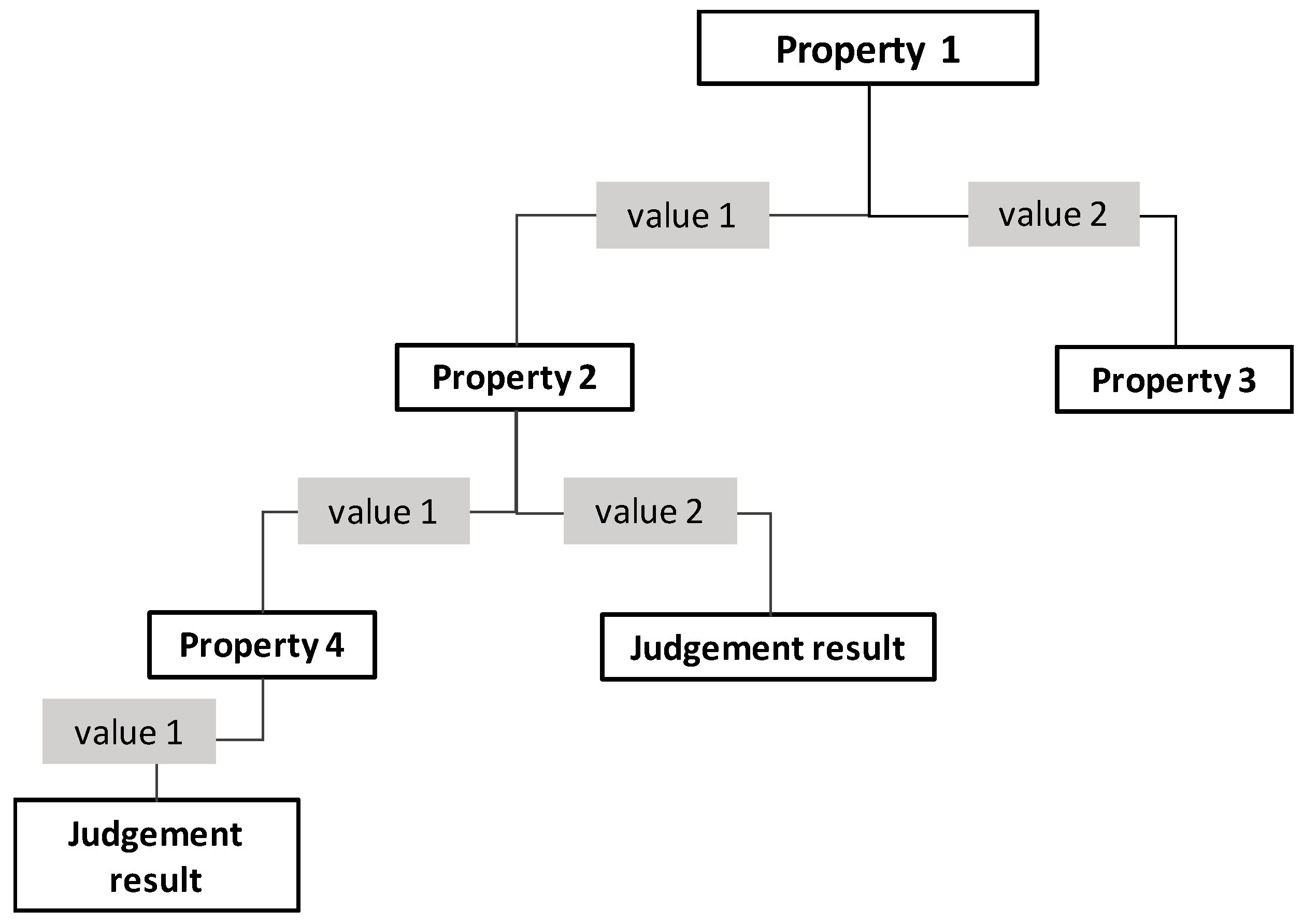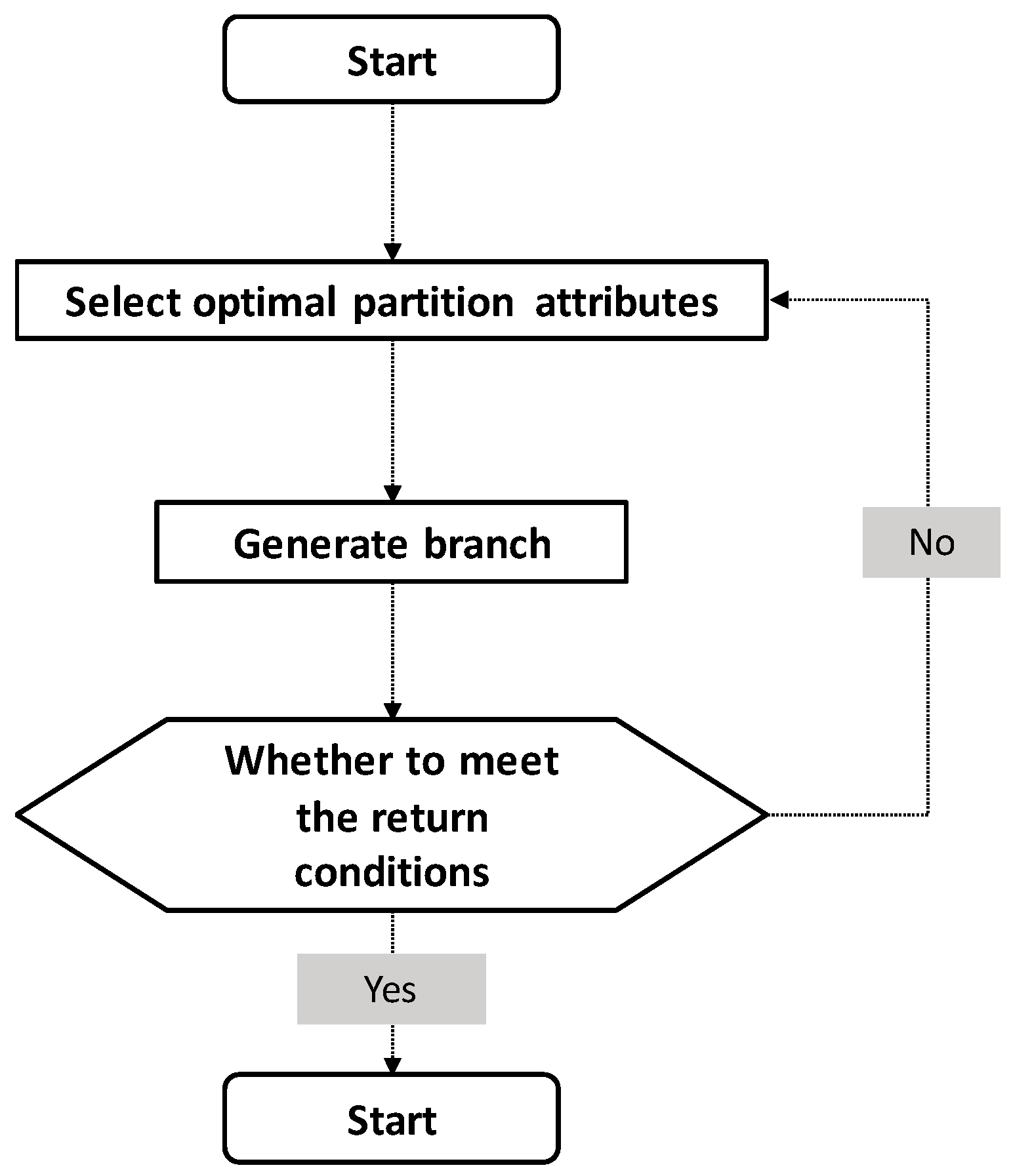Using the Machine Learning Method to Study the Environmental Footprints Embodied in Chinese Diet
Abstract
:1. Introduction
2. Materials and Methods
2.1. Data Processing
2.1.1. Environmental Footprint Calculation
2.1.2. Cluster Analysis of Environmental Footprint Data
2.2. Applying Machine Learning Methods to the Environmental Footprint Data of Food Systems
2.2.1. Select the Optimal Partition Attribute
2.2.2. Generate Branches
2.2.3. Determine Whether to Return
3. Results
3.1. Normal Distribution of Environmental Footprint Consumption
3.2. Identify Population Characteristics of Environmental Footprint in Food System
3.3. Comparison of the Consumption Ranking of Various Types of People under the Main Index Classification
3.3.1. The Characteristics of Water Footprint High-Consuming Groups
3.3.2. The Characteristics of Carbon Footprint High-Consuming Groups
3.3.3. The Characteristics of Ecological Footprint High-Consuming Groups
- low-income groups with high education levels who live in urban areas;
- high-income groups with low education levels who live in urban areas;
- high-income groups with high education levels who live in urban areas;
- high-income groups with high education levels who live in rural areas.
4. Discussion
4.1. Comparison with Previous Research and Implications of This Study
4.2. Strengths and Shortages
5. Conclusions
Supplementary Materials
Author Contributions
Funding
Conflicts of Interest
References
- Food and Agriculture Organization of the United Nations. The Water-Energy-Food Nexus: A New Approach in Support of Food Security and Sustainable Agriculture; Food and Agriculture Organization of the United Nations (FAO): Rome, Italy, 2014. [Google Scholar]
- Karabulut, A.; Egoh, B.N.; Lanzanova, D.; Grizzetti, B.; Bidoglio, G.; Pagliero, L.; Bouraoui, F.; Aloe, A.; Reynaud, A.; Maes, J.; et al. Mapping water provisioning services to support the ecosystem–water–food–energy nexus in the Danube river basin. Ecosyst. Serv. 2016, 17, 278–292. [Google Scholar] [CrossRef]
- United States National Intelligence Council. Global Trends 2030: Alternative Worlds; United States National Intelligence Council: Washington, DC, USA, 2012.
- Bazilian, M.; Rogner, H.; Howells, M.; Hermann, S.; Arent, D.; Gielen, D.; Steduto, P.; Mueller, A.; Komor, P.; Tol, R.S.; et al. Considering the energy, water and food nexus: Towards an integrated modelling approach. Energy Policy 2011, 39, 7896–7906. [Google Scholar] [CrossRef]
- National Bureau of Statistics. National Statistic Yearbook 2011; National Bureau of Statistics: Beijing, China, 2012.
- Zhang, W.-F.; Dou, Z.-X.; He, P.; Ju, X.-T.; Powlson, D.; Chadwick, D.; Norse, D.; Lu, Y.-L.; Zhang, Y.; Wu, L.; et al. New technologies reduce greenhouse gas emissions from nitrogenous fertilizer in China. Proc. Natl. Acad. Sci. USA 2013, 110, 8375–8380. [Google Scholar] [CrossRef] [PubMed] [Green Version]
- Liu, J.; Savenije, H.H.G. Food consumption patterns and their effect on water requirement in China. Hydrol. Earth Syst. Sci. 2008, 12, 887–898. [Google Scholar] [CrossRef] [Green Version]
- Gerber, P.J.; Steinfeld, H.; Henderson, B.; Mottet, A.; Opio, C.; Dijkman, J.; Falcucci, A.; Tempio, G. Tackling Climate Change Through Livestock—A Global Assessment of Emissions and Mitigation Opportunities; Food and Agriculture Organization of the United Nations (FAO): Rome, Italy, 2013. [Google Scholar]
- Hoekstra, A.Y.; Mekonnen, M.M. The water footprint of humanity. Proc. Natl. Acad. Sci. USA 2012, 109, 3232–3237. [Google Scholar] [CrossRef] [Green Version]
- Fader, K. The Omnivore’s Dilemma: A Natural History of Four Meals. Prev. Med. 2008, 47, 456–458. [Google Scholar] [CrossRef]
- Galli, A.; Wiedmann, T.; Ercin, A.E.; Knoblauch, D.; Ewing, B.; Giljum, S. Integrating Ecological, Carbon and Water Footprint into a “Footprint Family” of Indicators: Definition and Role in Tracking Human Pressure on the Planet. Ecol. Indic. 2012, 16, 100–112. [Google Scholar] [CrossRef]
- Li, Y.; Wang, L.-E.; Cheng, S. Spatiotemporal variability in urban HORECA food consumption and its ecological footprint in China. Sci. Total. Environ. 2019, 687, 1232–1244. [Google Scholar] [CrossRef]
- Yan, W.; Xiaoke, W.; Fei, F. Ecological Footprint and Water Footprint of Food Consumption in Beijing. Resour. Sci. 2011, 33, 1145–1152. [Google Scholar]
- Poore, J.; Nemecek, T. Reducing food’s environmental impacts through producers and consumers. Science 2018, 360, 987–992. [Google Scholar] [CrossRef] [Green Version]
- Zhang, Y.; Tian, Q.; Hu, H.; Yu, M. Water Footprint of Food Consumption by Chinese Residents. Int. J. Environ. Res. Public Health 2019, 16, 3979. [Google Scholar] [CrossRef] [PubMed] [Green Version]
- Liu, J.; Lundqvist, J.; Weinberg, J.; Gustafsson, J. Food Losses and Waste in China and Their Implication for Water and Land. Environ. Sci. Technol. 2013, 47, 10137–10144. [Google Scholar] [CrossRef] [PubMed]
- Gephart, J.A.; Davis, K.F.; Emery, K.A.; Leach, A.M.; Galloway, J.N.; Pace, M.L. The environmental cost of subsistence: Optimizing diets to minimize footprints. Sci. Total. Environ. 2016, 553, 120–127. [Google Scholar] [CrossRef] [PubMed] [Green Version]
- Vermeulen, S.J.; Campbell, B.M.; Ingram, J.S.I. Climate change and food systems. Annu. Rev. Environ. Resour. 2012, 37, 195–222. [Google Scholar] [CrossRef] [Green Version]
- Food and Agriculture Organization of United Nations (FAO). Introduction to Agricultural Water Pollution; Food and Agriculture Organization of United Nations (FAO): Rome, Italy, 1996; Available online: http://www.fao.org/docrep/w2598e/w2598e04.htm (accessed on 21 June 2020).
- UN-DESA. World Population Prospects: The 2015 Revision, Key Findings and Advance Tables; Working Paper No. ESA/P/WP.241; United Nations—Department of Economic and Social Affairs (UN-DESA), Population Division: New York, NY, USA, 2015. [Google Scholar]
- Zhang, X.; Li, H.-Y.; Deng, Z.D.; Ringler, C.; Gao, Y.; Hejazi, M.I.; Leung, L.R. Impacts of climate change, policy and Water-Energy-Food nexus on hydropower development. Renew. Energy 2018, 116, 827–834. [Google Scholar] [CrossRef]
- Conway, D.; Van Garderen, E.A.; Deryng, D.; Dorling, S.; Krueger, T.; Landman, W.A.; Lankford, B.; Lebek, K.; Osborn, T.; Ringler, C.; et al. Climate and southern Africa’s water–energy–food nexus. Nat. Clim. Chang. 2015, 5, 837. [Google Scholar] [CrossRef] [Green Version]
- Davis, K.F.; Gephart, J.A.; Emery, K.A.; Leach, A.M.; Galloway, J.N.; D’Odorico, P. Meeting future food demand with current agricultural resources. Glob. Environ. Chang. 2016, 39, 125–132. [Google Scholar] [CrossRef]
- Pinstrup-Andersen, P.; Pandya-Lorch, R. Food security and sustainable use of natural resources: A 2020 Vision. Ecol. Econ. 1998, 26, 1–10. [Google Scholar] [CrossRef]
- White, D.J.; Hubacek, K.; Feng, K.; Sun, L.; Meng, B. The Water-Energy-Food Nexus in East Asia: A tele-connected value chain analysis using inter-regional input-output analysis. Appl. Energy 2018, 210, 550–567. [Google Scholar] [CrossRef] [Green Version]
- Sherwood, J.; Clabeaux, R.; Carbajales-Dale, M. An extended environmental input–output lifecycle assessment model to study the urban food–energy–water nexus. Environ. Res. Lett. 2017, 12, 105003. [Google Scholar] [CrossRef] [Green Version]
- Garcia, D.; Galaz, V.; Daume, S. EATLancet vs yes2meat: The digital backlash to the planetary health diet. Lancet 2019, 394, 2153–2154. [Google Scholar] [CrossRef] [Green Version]
- Song, G.; Gao, X.; Fullana-I-Palmer, P.; Lv, D.; Zhu, Z.; Wang, Y.; Bayer, L.B. Shift from feeding to sustainably nourishing urban China: A crossing-disciplinary methodology for global environment-food-health nexus. Sci. Total Environ. 2019, 647, 716–724. [Google Scholar] [CrossRef]
- Xiao, D.; Heaney, C.; Mottet, L.; Fang, F.; Lin, W.; Navon, I.; Guo, Y.; Matar, O.; Robins, A.; Pain, C. A reduced order model for turbulent flows in the urban environment using machine learning. Build. Environ. 2019, 148, 323–337. [Google Scholar] [CrossRef] [Green Version]
- Lee, E.K.; Zhang, W.-J.; Zhang, X.; Adler, P.R.; Lin, S.; Feingold, B.J.; Khwaja, H.A.; Romeiko, X.X. Projecting life-cycle environmental impacts of corn production in the U.S. Midwest under future climate scenarios using a machine learning approach. Sci. Total Environ. 2020, 714, 136697. [Google Scholar] [CrossRef]
- Lei, X.; Lin, W. The New Cooperative Medical Scheme in rural China: Does more coverage mean more service and better health? Health Econ. 2009, 18, S25–S46. [Google Scholar] [CrossRef]
- Tudor-Locke, C.; E Ainsworth, B.; Adair, L.S.; Du, S.; Popkin, B.M. Physical activity and inactivity in Chinese school-aged youth: The China Health and Nutrition Survey. Int. J. Obes. 2003, 27, 1093–1099. [Google Scholar] [CrossRef] [Green Version]
- Jin, J.; He, R.; Kuang, F.; Wan, X.; Ning, J. Different sources of rural household energy consumption and influencing factors in Dazu, China. Environ. Sci. Pollut. Res. 2019, 26, 21312–21320. [Google Scholar] [CrossRef]
- Du, W.; Cohen, A.; Shen, G.F.; Ru, M.Y.; Shen, H.Z.; Tao, S. Fuel use trends for boiling water in rural China (1992–2012) and environment health implications: A national cross-sectional study. Environ. Sci. Technol. 2018, 52, 12886–12894. [Google Scholar] [CrossRef]
- Chen, G.; Zhu, Y.; Wiedmann, T.; Yao, L.; Xu, L.; Wang, Y. Urban-rural disparities of household energy requirements and influence factors in China: Classification tree models. Appl. Energy 2019, 250, 1321–1335. [Google Scholar] [CrossRef]
- Popkin, B.M.; Du, S.; Zhai, F.; Zhang, B. Cohort profile: The China healthand nutrition survey–monitoring and understanding socio-economic andhealth change in China, 1989–2011. Int. J. Epidemiol. 2010, 39, 1425–1440. [Google Scholar] [CrossRef] [Green Version]
- DFEP. The Literature Database of Reviewed LCA Studies on Foods. 2013. Available online: http://www.barillacfn.com/wpcontent/uploads/2013/05/BCFN_DATABASE_FOR_DOUBLE_PYRAMID_2012.zip (accessed on 21 January 2020).
- Fletcher, S.; Islam, Z. Decision Tree Classification with Differential Privacy. ACM Comput. Surv. (CSUR) 2019, 52, 1–33. [Google Scholar] [CrossRef] [Green Version]
- Quinlan, J.R. Induction of decision trees. Mach. Learn. 1986, 1, 81–106. [Google Scholar] [CrossRef] [Green Version]
- Phu, V.N.; Tran, V.T.N.; Chau, V.T.N.; Dat, N.D.; Duy, K.L.D. A decision tree using ID3 algorithm for English semantic analysis. Int. J. Speech Technol. 2017, 20, 593–613. [Google Scholar] [CrossRef]
- Gaddam, S.R.; Phoha, V.V.; Balagani, K.S. K-Means+ID3: A Novel Method for Supervised Anomaly Detection by Cascading K-Means Clustering and ID3 Decision Tree Learning Methods. IEEE Trans. Knowl. Data Eng. 2007, 19, 345–354. [Google Scholar] [CrossRef]
- Food and Agriculture Organization of the United Nations. Food Consumption and Nutritional Status in China. Available online: http://www.fao.org/3/u5900t/u5900t0a.htm (accessed on 23 June 2020).
- Garcia-Herrero, I.; Hoehn, D.; Margallo, M.; Laso, J.; Bala, A.; Batlle-Bayer, L.; Fullana, P.; Vazquez-Rowe, I.; Gonzalez, M.; Durá, M.; et al. On the estimation of potential food waste reduction to support sustainable production and consumption policies. Food Policy 2018, 80, 24–38. [Google Scholar] [CrossRef]
- Ulucak, R.; Bilgili, F. A reinvestigation of EKC model by ecological footprint measurement for high, middle and low income countries. J. Clean. Prod. 2018, 188, 144–157. [Google Scholar] [CrossRef]
- Fang, Z.; Chen, Y. Electricity Consumption, Education Expenditure and Economic Growth in Chinese Cities. Liverpool, RIEI WP series. no. 2017e2. 2017. Available online: 58.210.89.21/RePEc/xjt/working-papers/RIEI-WP_2017-02.pdf (accessed on 21 June 2020).
- Chankrajang, T.; Muttarak, R. Green Returns to Education: Does Schooling Contribute to Pro-Environmental Behaviours? Evidence from Thailand. Ecol. Econ. 2017, 131, 434–448. [Google Scholar] [CrossRef] [Green Version]
- Elena, D.G.; Ioana, V.L.; Amalia, D.M. Ecological Footprints in Romania—Urban Versus Rural Area; Institute of Electrical and Electronics Engineers (IEEE): Pictasaway, NJ, USA, 2019; pp. 439–443. [Google Scholar]
- Chai, L.; Han, Z.; Liang, Y.; Su, Y.; Huang, G. Understanding the blue water footprint of households in China from a perspective of consumption expenditure. J. Clean. Prod. 2020, 262, 121321. [Google Scholar] [CrossRef]
- Cao, Y.; Chai, L.; Yan, X.; Liang, Y. Drivers of the Growing Water, Carbon and Ecological Footprints of the Chinese Diet from 1961 to 2017. Int. J. Environ. Res. Public Health 2020, 17, 1803. [Google Scholar] [CrossRef] [Green Version]
- Luo, T.W.; Ouyang, Z.Y.; Wang, X.K.; Miao, H.; Zheng, H. Dynamics of urban food-carbon consumption in Beijing households. Acta Ecol. Sin. 2005, 25, 3252–3258. [Google Scholar]







| Rank | 1st | 2nd | 3rd | |||
|---|---|---|---|---|---|---|
| Influence Factor | Gender | Income Level | Education Level | |||
| Classification | male | female | very low to middle | high to very high | low | high |
| Entropy Value | 1.556 | 1.553 | 1.573 | 1.564 | 1.575 | 1.562 |
| Information Divergence | 0.029 | 0.032 | 0.012 | 0.021 | 0.01 | 0.023 |
| Rank | 1st | 2nd | 3rd | |||
|---|---|---|---|---|---|---|
| Influence Factor | Gender | Education Level | Income Level | |||
| Classification | male | female | low | high | very low to middle | high to very high |
| Entropy Value | 1.548 | 1.540 | 1.573 | 1.559 | 1.577 | 1.57 |
| Information Divergence | 0.037 | 0.045 | 0.012 | 0.026 | 0.008 | 0.015 |
| Rank | 1st | 2nd | 3rd | |||
|---|---|---|---|---|---|---|
| Influence Factor | Income Level | Region | Education Level | |||
| Classification | very low to middle | high to very high | urban | rural | low | high |
| Entropy Value | 1.539 | 1.528 | 1.545 | 1.553 | 1.56 | 1.541 |
| Information Divergence | 0.046 | 0.057 | 0.04 | 0.032 | 0.025 | 0.044 |
© 2020 by the authors. Licensee MDPI, Basel, Switzerland. This article is an open access article distributed under the terms and conditions of the Creative Commons Attribution (CC BY) license (http://creativecommons.org/licenses/by/4.0/).
Share and Cite
Liang, Y.; Han, A.; Chai, L.; Zhi, H. Using the Machine Learning Method to Study the Environmental Footprints Embodied in Chinese Diet. Int. J. Environ. Res. Public Health 2020, 17, 7349. https://doi.org/10.3390/ijerph17197349
Liang Y, Han A, Chai L, Zhi H. Using the Machine Learning Method to Study the Environmental Footprints Embodied in Chinese Diet. International Journal of Environmental Research and Public Health. 2020; 17(19):7349. https://doi.org/10.3390/ijerph17197349
Chicago/Turabian StyleLiang, Yi, Aixi Han, Li Chai, and Hong Zhi. 2020. "Using the Machine Learning Method to Study the Environmental Footprints Embodied in Chinese Diet" International Journal of Environmental Research and Public Health 17, no. 19: 7349. https://doi.org/10.3390/ijerph17197349







